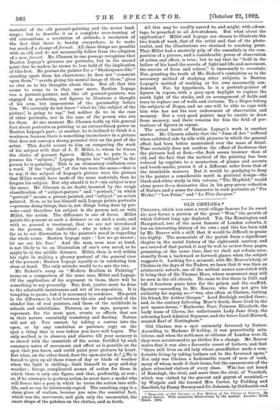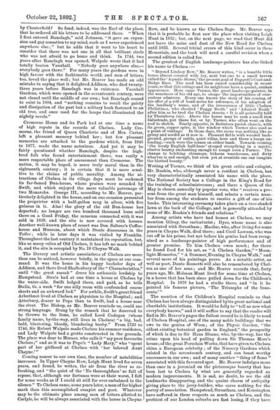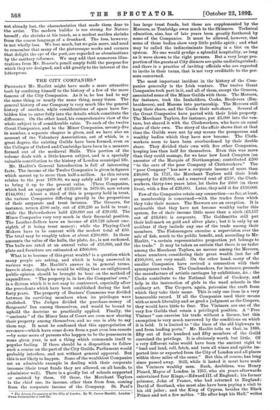OLD CHELSEA.* CHELSEA, which was once a rural village famous
for its sweet air, now forms a portion of the great "Wen," the growth of which Cobbett long ago deplored. Yet, like Kensington and Hampstead, two of the most famous of London suburbs, it has an interesting history of its own ; and this has been told by Mr. Beaver with a skill that it would be difficult to praise too highly. The memorials of the parish form a significant chapter in the social history of the eighteenth century, and as a record of that period, it may be well to review these pages, premising, at the same time, that we shall not refrain occa- sionally from a backward or forward glance when the subject suggests it. Looking for a moment, with Mr. Beaver's help, at Chelsea in the days of the Tudors, we learn that it was then an aristocratic suburb, one of the noblest names associated with it being that of Sir Thomas More, whose monument may still be seen in the old church. He came to live there in 1520, and left it fourteen years later for the prison and the scaffold. Spenser—according to Mr. Beaver, who does not give his authority for saying so—" was also often at Chelsea, visiting his friend, Sir Arthur Gorges." Lord Burleigh resided there ; and, in the century following More's death, there lived in the new manor-house, "Katherine Parr, Princess Elizabeth, the Lady Anne of Cleves, the unfortunate Lady Jane Grey, the scheming Lord Admiral Seymour, and the brave Lord Howard, created Earl of Nottingham."
Old Chelsea was a spot eminently favoured by Nature. According to Madame D'Arbley, it was proverbially salu- brious, and when the noblemen or citizens of London were ill, they were accustomed to go thither for a change. Mr. Beaver states that it was also a favourite resort of bathers, and that "there still lives an old lady whose grandfather made a com- fortable living by taking bathers out to the favoured spots." Not only was Chelsea a fashionable resort of men of rank, many of whom made it their home, but the amusements of the place attracted visitors of every class. Who has not heard of Ranelagh, the rival, and more than the rival, of Vauxhall, which was visited by the gravest and gayest of mankind,— by Walpole and the learned Mrs. Carter, by Fielding and Smollett, by Fanny Burney and Dr. Johnson, by Goldsmith and
• Memorials of _Old Chelsea: a New History of Alfred Beaver. With numerous Illustrations by London: Late:F.11ra Stock. 1892. by Chesterfield? So fond, indeed, was the Earl of the place, that he ordered all his letters to be addressed there. "When I first entered Ranelagh," said Johnson, "it gave an expan- sion and gay sensation to my mind, such as I never experienced anywhere else ; " but he adds that it went to his heart to consider that there was not one in all that brilliant circle who was not afraid to go home and think. In 1744, two years after Ranelagh was opened, Walpole wrote that it had totally beaten Vauxhall. "Nobody goes anywhere else,— everybody goes there." For many years the gardens were in high favour with the fashionable world, and men of letters, too, loved the place well ; but Mr. Beaver has made an odd mistake in saying that it delighted Addison, who died twenty- three years before Ranelagh was in existence. Vauxhall Gardens, which were opened in the seventeenth century, were not closed until the middle of our own ; but Ranelagh ceased to exist in 1804, and "nothing remains to recall• the 'gaiety and dissipation of the past but a solitary hook fastened to an old tree, and once used for the lamps that illuminated the nightly revels."
Cremorne House and its Park had at one time a name of high repute in the records of Chelsea. Lady Cre- morne, the friend of Queen Charlotte and of Mrs. Carter, left a pleasant memory behind her ; bat few pleasant memories are attached to the gardens which, from 1845 to 1877, made the name notorious. And yet it may be fairly questioned whether Ranelagh, despite the high- bred folk who found entertainment there, was really a more respectable place of amusement than Cremorne. The nation, it may be hoped, is more truly moral than in the eighteenth century ; it is certain that it is more sensi- tive to the claims of public morality. Among the at- tractions of Chelsea in its village days must be reckoned its far-famed Bun-house, whose praises were sounded by Swift, and which enjoyed the more valuable patronage of two Monarchs. George III., according to Mr. Beaver, par- ticularly delighted in the house, and on one occasion presented the proprietor with a half-gallon mug in silver, with five guineas in it. Alas ! the glory of the old Bun-house has departed; no longer are two hundred thousand buns sold there on a Good Friday, the museum connected with it was sold in 1839, and the site is now covered with houses. Another well-known place of resort was Don Saltero's Coffee- house and Museum, about which Steele discourses in the Taller ; while in later days it was visited by Franklin. Throughout the last century it maintained its reputation, but, like so many relics of Old Chelsea, it has left no mark behind it, and the site is occupied by No. 18 Cheyne Walk.
The literary and artistic associations of Chelsea are more than can be noticed, however briefly, in the space at our com- mand. It was the home in his happy bachelor days of Addison, and there lived Shaftesbury of the" Characteristics," until "the great smoak " drove his asthmatic lordship to Hampstead. Steele had at one time a house at Chelsea by the water-side. Swift lodged there, and paid, as he tells Stella, 6s. a week "for one silly room with confounded coarse sheets and an awkward bed." For awhile, Swift's great friend Arbuthnot lived at Chelsea as physician to the Hospital ; and Atterbury, dearer to Pope than to Swift, had a house near the river. The Bishop, as Mr. Beaver reminds us, could use strong language. Stung by the remark that he deserved to be thrown to the lions, he called Lord Cadogan (whose family name, by-the-way, still lives in Chelsea) "a big, bad, bold, blustering, bloody, blundering booby." From 1723 to 1746, Sir Robert Walpole made Chelsea his summer residence, and Lady Walpole had a grotto constructed in the grounds. The place was dear to Horace, who calls it "my poor favourite Chelsea ;" and so it was to Pope's "Lady Mary," who "spent part of her girlhood at Chelsea with her beloved Aunt Cheyne."
Coming nearer to our own time, the number of notabilities increases. In Upper Cheyne Row, Leigh Hunt lived for seven years, and found, he writes, the air from the river so re- freshing, and "the quiet of the 'No thoroughfare' so full of repose, that, although our fortunes were at their worst, I felt for some weeks as if I could sit still for ever embalmed in the silence." To Chelsea came, some years later, a man of far higher mark than this accomplished essayist and poet. Whatever may be the ultimate place among men of letters allotted to Carlyle, he will be always associated with the house in Cheyne Row, and be known as the Chelsea Sage. Mr. Beaver says that it is probable he first saw the place when visiting Leigh Hunt in 1832; but, on the next page, we read that Hunt did not leave the noise and dust of the New Road for Chelsea until 1833. Several trivial errors of this kind occur in these Memorials, and the book will need a careful revision when a second edition is called for.
The greatest of English landscape-painters has also linked his name to Chelsea :—
"Beyond Lindsey Row;' Mr. Beaver writes, is a humble little house almost covered with ivy, next but one to a small tavern called the Aquatic Stores,' the present goal of Doggett's Coat-and- Badge Race. The road has been raised considerably in recent years, so that this cottage and its neighbour have a quaint, sunken appearance. Here came Turner, the great landscape-painter, in the weariness of his old age, to escape the importunities of over- zealous admirers. Every one knows the story of his coming, of his offer of a roll of bank-notes for reference, of his adoption of the landlady's name, and of the irreverence of little Chelsea Philistines, who shouted Puggy Booth' and Admiral Booth after him as he trod the Chelsea streets. - It is all pointedly told by Thornberry (sic). Above the house may be seen a small iron balustrade, put there for, or by, Turner, who often went on the roof to sketch. Nearly opposite, in Battersea parish church, with its green, copper spire, is the window which Turner also used as a point of vantage. In those days, the scene was nothing like as grimy and sordid as it now is. Pleasant fields with wooded back- ground, groups of cattle, quiet villas, here and there a barge un- loading.--such were the scenes on either bank. Towards evening
the lovely English half-haze' steeped everything in a mystic, elusive beauty enchanting enough to tempt even a Turner. The change to belching chimneys, hideous warehouses, and dirty wharves is sad enough, but even yet at eventide one can imagine the blotted beauty."
Writing of Turner, we think of his great critic and eulogist,
Mr. Ruskin, who, although never a resident in Chelsea, has very characteristically associated his name with the place. The National Society has a College in the King's Road for the training of schoolmistresses; and there a Queen of the May is chosen annually by popular vote, who "receives a pre, sent from the great man himself, and selects a certain num- ber from among the students to receive a gift of one of his. books. This interesting ceremony takes place on a tree-shaded lawn at the back of the College, and is generally attended by some of Mr. Ruskin's friends and relations."
Among artists who have had homes at Chelsea, we may mention Gilray, the caricaturist ; Dyce, whose name is also. associated with Streatham ; Maclise, who, after living for some years in Cheyne Walk, died there; and Cecil Lawson, who was cut off in his prime, but not before his genius had been recog- nised as a landscape-painter of high performance and of greater promise. To him Chelsea owes much ; for there he found food for his art, as "A Chelsea Garden," "Moon- light Memories," "A Summer:Evening in Cheyne Walk," and several more of hi a paintings prove. As a notable artist, as well as poet, Dante Rossetti will also be remembered by Chel- sea as one of her sons ; and Mr. Beaver records that, forty years ago, Mr. Holman Hunt lived for some time at Chelsea, in a house that has been since pulled down for the Children's Hospital. In 1878 he had a studio there, and "in it he painted his famous picture, The Triumphs of the limo- cents.'" The mention of the Children's Hospital reminds us that Chelsea has been always distinguished by its great national and charitable institutions. It would be folly to "tell as new what everybody knows," and it will suffice to say that the reader will find in Mr. Beaver's pages the fullest record he is likely to need of Chelsea Hospital, one of the many noble buildings that we owe to the genius of Wren ; of the Physic Garden, "the oldest existing botanical garden in England," the prosperity of which is due to Sir Hans Sloane, who, by-the-way, has the crime upon his head of palling down Sir Thomas More'a house; of the great Porcelain Works, that have given to Chelsea china a European celebrity ; of the Nursery Gardens which existed in the seventeenth century, and can boast worthy successors in our own ; and of many another "thing of fame associated with this favoured spot. Mr. Beaver indulges more than once in a jeremiad on the picturesque beauty that has been lost to Chelsea by what are generally regarded as modern improvements. It is sad, no doubt, to see the old landmarks disappearing, and the quaint charm of antiquity giving place to the jerry-builder, who cares nothing for the poetry of association. Hampstead, Streatham, and Kensington have suffered in these respects as much as Chelsea, and the prettiest of our London suburbs are fast losing, if they have not already lost, the characteristics that made them dear to the artist. The modern builder is too strong for Nature herself ; she shrinks at his touch, as a modest maiden shrinks from the coarse language of a drunkard. The loss, however, is not wholly loss. We lose much, but we gain more, and need to remember that many of the picturesque nooks and corners that delight the eye of the poet, are regarded as abominations by the sanitary reformer. We may add that numerous illus- trations from Mr. Beaver's pencil amply fulfil the purpose for which they are designed, and add greatly to the interest of the letterpress.








































 Previous page
Previous page